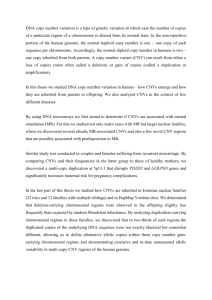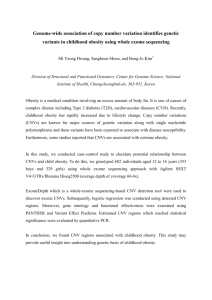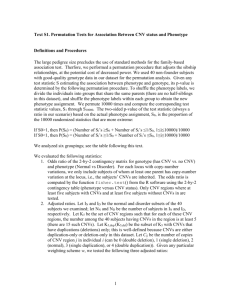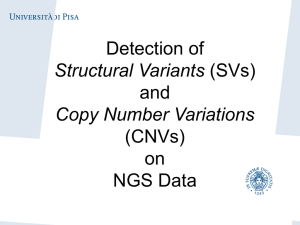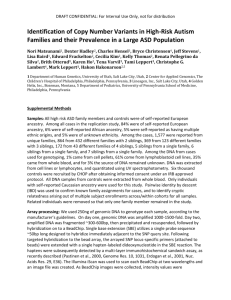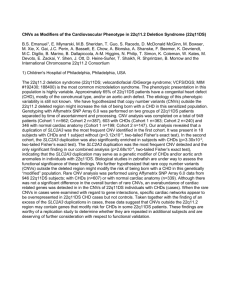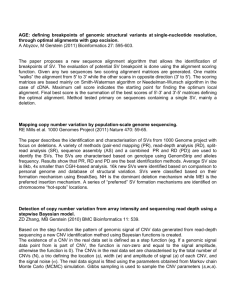081610_cap_cytogenetic_comments
advertisement
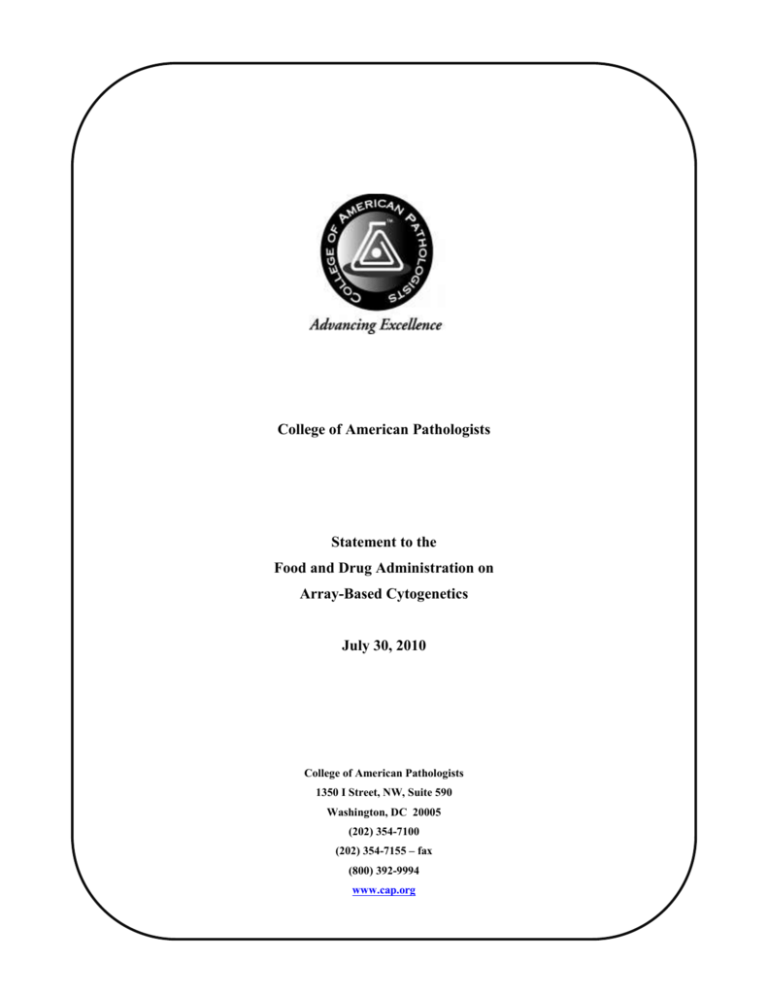
College of American Pathologists Statement to the Food and Drug Administration on Array-Based Cytogenetics July 30, 2010 College of American Pathologists 1350 I Street, NW, Suite 590 Washington, DC 20005 (202) 354-7100 (202) 354-7155 – fax (800) 392-9994 www.cap.org Detailed CAP Response to FDA on Array-based Cytogenetics The College of American Pathologists is a national medical specialty society representing more than 17,000 pathologists who practice anatomic pathology and laboratory medicine in laboratories worldwide. The College's Commission on Laboratory Accreditation is responsible for accrediting more than 6,000 laboratories here and abroad. Our members have extensive expertise providing and directing laboratory services and participate as peer inspectors in the laboratory accreditation program. The College has been a leader in developing quality improvement programs for laboratories, including programs in genetic testing. The College’s Laboratory Accreditation Program stresses both analytic and clinical validation prior to introducing any new test into routine practice, recognizing that tests will continue to be periodically improved after introduction with each improvement revalidated by the laboratory before use on patient samples. GENERAL COMMENTS As medical specialists in the diagnosis of disease, pathologists have a long track record of delivering high quality services to patients through the practice of laboratory medicine. College members feel that array-based cytogenetic tests are not unlike numerous other laboratory tests that they have successfully introduced into medical practice. Array-based cytogenetics constitutes an important and expanding aspect of the medical practice of laboratory professionals for decades to come. The College therefore has a keen interest in ensuring that our ability to interpret tests based on professional expertise in order to provide high quality diagnostic services to patients and other physicians we serve is not unduly restricted. Patient care is compromised when diagnostic testing services are less readily and affordably available because of 2 Detailed CAP Response to FDA on Array-based Cytogenetics burdensome regulation. Indeed, we believe that the principle of “least burdensome,” which the Agency applies to the 510(k) and PMA reviews should apply to any new requirements in this arena as well. CLIA provides the necessary framework and standards to assure quality laboratory testing through its accreditation requirements. Please consider that CLIA already requires assessment of analytical validity for all assays offered by a laboratory regardless of whether these test are regulated analytes. The CAP accreditation program already provides the necessary standards to assure quality laboratory testing as required by CLIA. This is due in part to the robust nature and rigorous attention to CLIA quality standards and practices as well as medical oversight of every clinical laboratory by a physician. SPECIFIC RESPONSES TO FDA QUESTIONS POSED IN THE FEDERAL REGISTER NOTICE In order to provide a detailed response to the FDA request, CAP sought input from its Public Health Policy Committee and its joint CAP ACMG Cytogenetics Resource Committee1 who carefully considered the questions posed in the Federal Register. Please consider the following recommendations2. 1 The Joint CAP/ACMG Cytogenetics Resource Committee is responsible for providing and developing effective and timely proficiency testing in the clinical practice of cytogenetics, including both conventional cytogenetics and molecular cytogenetics, and is charged with defining and monitoring state of the art and emerging technology in both conventional cytogenetics and molecular cytogenetics; providing expertise and consultation in the clinical practice of cytogenetics to other components of the College of American Pathologists and its members and to the American College of Medical Genetics and its members; and advising on public policy as it applies to the clinical practice of cytogenetics. 2 All responses are related to post-natal, non-neoplastic constitutional diseases that may be caused by genomic imbalances, unless otherwise specified. 3 Detailed CAP Response to FDA on Array-based Cytogenetics 1. Clinical significance a. The resolution of array-based cytogenetic tests and the presence of copy number variations (CNVs) in the apparently healthy population pose challenges for result interpretation. What criteria should be used to determine the clinical significance of CNVs (e.g., when categorized as benign, pathogenic, or of unknown significance)? Databases and data sets of normal copy number variation obtained from large population studies should play a significant role in interpretation of CNVs found through clinical testing using array based methodologies. Some commonly used sources of this type of data include: 1. The 42M High-Resolution CNV Discovery Project conducted by the Genome Structural Variation Consortium3 (data available at http://www.sanger.ac.uk/humgen/cnv/42mio/) 2. The Copy Number Variation database developed at the Children's Hospital of Philadelphia (CHOP) (http://cnv.chop.edu/) 3. The Database of Genomic Variants (http://projects.tcag.ca/variation/) (also known as the Toronto Database) The presence of a particular CNV or group of CNVs within a healthy population does not completely exclude pathogenicity, especially in potentially complex or polygenic diseases. However, based on data from pediatric populations with constitutional syndromes or congenital abnormalities it is clear that the presence of the types of CNVs associated with “healthy” populations alone do not result in these severe phenotypes. In the absence of sequence data or zygosity information from a SNP array for each CNV locus (to examine all alleles) the following general rules can be applied to classify CNVs according to clinical significance. We suggest the following criteria as discussed in the literature (please also refer to Table 1 found in: Miller DT, Adam MP, Aradhya S, et al. Consensus statement: chromosomal microarray is a first-tier clinical diagnostic test for individuals with developmental 3 Both the 42M High-Resolution CNV Discovery Project and the Copy Number Variation database developed at the Children's Hospital of Philadelphia (CHOP) state how many healthy, "normal" individuals were tested to construct their data sets. In contrast, there is no one number of individuals that have been tested for the information present within the Database of Genomic Variants (DGV). There are also individual publications that report the results of the CNV Discovery Project and the CHOP data set (Conrad 2010 and Shaikh 2009) whereas there are numerous publications describing the content of the DGV. In the case of the DGV the individual number of controls tested and the number of controls in which the CNV in question was found needs to be obtained from either the DGV itself or from the primary research article in which it was described. Furthermore, in reference to the DGV, the technology used to identify the CNV present in the database should also be considered with the knowledge that older reports using BAC arrays are likely to have poorer resolution than more recent reports utilizing oligonucleotide arrays. 4 Detailed CAP Response to FDA on Array-based Cytogenetics disabilities or congenital anomalies. Am J Hum Genet 2010;86(5):749-764. [May 14, 2010].) Benign CNV – present in > 1% of the normal population - inherited from a healthy parent - present in unaffected blood relative - does not include known or suspected disease causing genes - is in a gene-poor region These are CNVs that are generally adequately described in public data sets (see above) or found within healthy, "normal" family members. The latter situation is commonly referred to as a benign, familial CNV. It should be noted that incomplete penetrance cannot be ruled out in these cases and should be stated in any clinical report. It may also be an appropriate assumption to call CNVs that occur within intergenic regions or within introns benign as well. Whereas this assumption is likely to hold true in the majority of cases there will undoubtedly be exceptions to this rule as more data is collected and function studies performed. Pathogenic CNV - de novo or inherited from an affected parent - present in affected relative - overlaps region reported in a phenotypic database such as DECIPHER - includes known or suspected disease causing genes - is a homozygous deletion These are CNVs that are not present within one or more of the data sets above, not found in healthy, "normal" family members, and in the setting of additional affected family members, segregates with disease. If the CNV is de novo in the affected subject it greatly increases the likelihood that it is pathogenic. It may also be an appropriate assumption that any pathogenic CNV must also involve at least one exon of at least one gene. Also, whereas this assumption is likely to hold true in the majority of cases, there will undoubtedly be exceptions to this rule as more data is collected and functional studies performed. Uncertain Clinical Significance CNV - anything that doesn’t clearly fit either of the above categories This may be the most appropriate category for CNVs that are not present within one or more of the three databases noted above, are de novo in the subject being tested and may not involve the coding region of any annotated gene. This category may also be appropriate for CNVs that have been reported at extremely rare frequencies in supposedly healthy, "normal" individuals who may never have been appropriately assessed for the symptoms being investigated in the subject currently being tested. 5 Detailed CAP Response to FDA on Array-based Cytogenetics b. Should there be different requirements implemented for interpreting the clinical significance of deletions vs. duplications vs. translocations? Early evidence suggests that duplications may result in less severe genetic phenotypes than deletions, and that deletions are more likely to cause a genetic phenotype than duplications. However, both genetic lesions can result in a dramatic phenotype depending on the locus and the genes or regulatory sequences affected. Translocations are the same in that depending on the loci involved in the breakpoints they have just as much capacity to be pathogenic as either a duplication or deletion. The primary consideration is location of the genetic lesion (as well as segregation of the lesion and other factors) not the type of lesion or the mechanism in which it was created.4,5 We suggest rephrasing the question as “Should there be different criteria for interpreting the clinical significance of deletions vs. duplications vs. translocations?” Yes. Following general cytogenetic guidelines, a deletion (loss of genetic material) is more likely to be clinically significant than a duplication (gain of genetic material), and the size of the affected region may have importance depending on the gene(s) involved. For translocations, it is important to clearly define/study the region of the breakpoints to assess clinical significance. This is analogous to the interpretation criteria used by clinical cytogeneticists for many years. 2. Result reporting and interpretation a. Should result output be limited to results associated with known syndromes that can be adequately validated clinically and analytically? No. We believe data should be communicated as completely as possible – with appropriate qualifiers as to whether clinical significance is known. If size limits are problems, those should be stated up front and NOT reported if below the stated criteria. If a CNV can be demonstrated to segregate within affected family members or not within healthy, "normal" family members and it also happens to involve a gene or genes that are known or likely to be involved in similar phenotypes then there is a very high probability that this CNV is pathogenic. This information could be very clinically useful to the family under investigation. All known syndromes started out as unknown syndromes. It is not until more of the currently unknown syndromes are documented and published in case reports that they can be recognized as known syndromes. 4 Shaikh, T., et. al., (2009) High-resolution mapping and analysis of copy number variations in the human genome: a data resource for clinical and research applications. Genome Res. 2009 Sep;19(9):1682-90. 5 Conrad, D., et. al., (2010) Origins and functional impact of copy number variation in the human genome. Nature. 464(7289):704-12. 6 Detailed CAP Response to FDA on Array-based Cytogenetics Lastly, an analogous situation exists in current DNA sequencing tests which are designed to find not only known, well-described mutations but also novel mutations which have previously been uncharacterized. Current standard practice is to report these novel mutations. It can be inferred that a similar practice applied to CNV detection is appropriate. *For prenatal diagnosis and oncology studies, we believe different criteria should be followed; these are not addressed at this time. b. What criteria (e.g., minimum overlap, size, etc.) should be used to conclude findings are indicative of known syndrome? In the case of known syndromes in which a specific gene or genes have been primarily attributed to the phenotype, then it should be inclusion of those genes (and specifically the exonic segments) within the CNV that is used to conclude that the findings are indicative of a known syndrome. The presence within the CNV of a gene or genes (specifically their exons) known to be associated with a known syndrome should support the diagnosis of that syndrome. A CNV that clearly disrupts the structure of a reported gene should be considered as having potential clinical significance regardless of its size. If deletion/duplication regions overlap with those in reported syndromes, the CNV should be described. If not, parental transmission should be determined. Furthermore, if the syndrome is the result of a loss of function then the CNV should be a deletion. If the syndrome is the result of a gain of function then the CNV should be a duplication. Lastly, the diagnosis of a known syndrome relies not on the genetic diagnosis alone. The inclusion of phenotypic characteristics is also necessary for the diagnosis of known, characterized syndromes. Consensus of critical region with minimum overlap and correlation with clinical findings should be obtained. c. Should the performing, ordering and/or result interpretation of these tests be limited to certain professionals (e.g., clinical cytogeneticists)? Result interpretation should be defined as the generation of a laboratory report from the data obtained and should be limited to certified genetics professionals as defined by the CAP LAP Checklists and ACMG Standards and Guidelines. Ordering, performance, and interpretation of tests should be consistent with current Federal and State Law. d. How does FDA ensure that the results are interpreted correctly? FDA can regulate the quality of the products; however, interpretation requires medical oversight and is currently overseen as are other laboratory tests. 7 Detailed CAP Response to FDA on Array-based Cytogenetics 3. Additional and confirmatory testing a. Should any array-based cytogenetic testing of an affected individual include testing of parents where possible? Yes, for abnormal or uncertain array findings. Parental testing is particularly important in the setting of previously unreported CNVs. The follow-up parental testing does not necessarily need to be array-based. b. Should a second follow up test (e.g., FISH) be required for result confirmation prior to reporting array-based cytogenetic results? No, it should not be required for reporting; indications for and type of follow-up testing must be individualized for each case. 4. Incidental findings a. Laboratories are obliged to report clinically significant findings unrelated to the test order, when identified. How can the reporting of results for diseases or conditions outside of the indications for use be restricted? Unexpected but clinically important findings will be reported based on guidelines currently being developed by the ACMG. Laboratories are obliged to report clinically significant findings unrelated to the test order, when identified. 5. Clinical evaluation for approval of array-based cytogenetic devices a. Would validation of a group of CNVs associated with well-known syndromes be acceptable as a representation of all types of detectable CNVs? For purposes of clinical validation – Yes; however, it is unnecessary to use only wellknown syndrome CNVs. Any CNV that has been validated by an alternative method and is above the limit of detection for the given array resolution can be used for array validation purposes. For purposes of analytic validation – each array platform would have to be validated according to CAP and ACMG guidelines. Please refer to ACMG guidelines for validation. Section: E13.2.4.1 found on www.acmg.net. b. If yes, then which syndromes should be included and how many CNVs would be a representative number? The final number should be determined by a consensus committee with representation by CAP and ACMG. Examples include, but are not limited to: 1p36.3 deletion, 4p deletion, 5p deletion, 7q deletion (Williams syndrome) and 7q duplication, 15q deletion, and 22q deletion. 8 Detailed CAP Response to FDA on Array-based Cytogenetics c. What should be used as the reference genome? No universally accepted standard reference genome (or pooled genomes) is available at this time. Commercially available reference genome mixtures exist and are currently used by many laboratories for BAC and oligo microarrays. SNP based reference is performed in silico and is based on either a HapMap reference cohort or extensive inhouse developed cohort. Some concerns that must be addressed when defining a reference genome include whether to use sex mismatched versus matched controls, single individuals versus multiple individuals, and population-based issues. An important issue is consistency and if the reference genome sample is changed it should be tested against known CNVs for maintenance of performance. A consensus workshop on this topic would be desirable, to include representation from CAP and ACMG. d. What studies should be performed to understand clinical specificity? For known syndromes, a minimum series of well-documented individuals (e.g. five) with the same or similar phenotype should be studied to establish pathogenic CNV correlations as noted in 5b. For unique findings, refer to established phenotypic databases and follow procedures that have been used in clinical cytogenetics reporting for the last 40 years. 6. Use of database(s) in result reporting a. How can the accuracy of information used in the determination of results be assured? NIH and ACMG are representative organizations attempting to standardize one or more commercial databases for normal and abnormal results. Each lab also has the opportunity to validate findings with ongoing clinical correlation. Internal validation studies and familiarization with the assay and analyses are part of standard laboratory practice. Ongoing performance is monitored by CAP LAP inspection checklist and proficiency testing. Quality control and quality assurance programs should be performed as standard laboratory practice. i. Who should develop and maintain a curated database of known/probable CNV changes and benign findings in the population? Currently available databases include ISCA, DGV, and DECIPHER databases. Clearly, the larger the database the better, because the data is more inclusive of representative results in the general population. Inclusion of any large or commercial databases would be extremely helpful. Each database currently has its own curator, and we recommend that if a larger meta-database is developed, that it should have representation by CAP and ACMG. 9 Detailed CAP Response to FDA on Array-based Cytogenetics ii. FDA regulations require that all aspects of a test involved in result output are under design controls in accordance with the Quality System regulations. When implementing the database for result reporting, how can it be assured that the database is adequately maintained and meets appropriate quality standards? While guidelines remain to be developed some considerations for standard laboratory information systems already exist in the CAP LAP checklist. SUMMARY The CAP believes that pathologists and other laboratory professionals use their professional expertise and knowledge of the literature and available resources to interpret the results of array-based cytogenetics. We recommend that any changes to federal oversight of array-based cytogenetics not interfere with medical practice of pathology and laboratory medicine. In addition, we recommend that any changes to federal oversight of array-based cytogenetics take into account the professional expertise required to interpret array-based cytogenetic tests. Pathologists and other laboratory professionals are key sources of knowledge and experience on the delivery of high quality, cost-effective laboratory services, and the CAP is willing and eager to contribute to discussions with clinicians, regulators, payers, and others sharing our common interests. Please don’t hesitate to contact Fay Shamanski, Ph.D., CAP Assistant Director, Public Health and Scientific Affairs at fshaman@cap.org if you have any questions on these comments. 10
